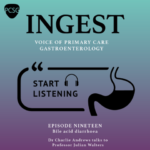Bile acid diarrhoea

In this episode, Charlie Andrews speaks to Professor Julian Walters about bile acid malabsorption and diarrhoea. With up to a third of patients with diarrhoea-predominant IBS having underlying bile acid diarrhoea, and with diagnosis rates for this condition being low, this episode is an important one for anyone working in primary care. We explore the role and physiology of bile acids, the causes and symptoms of bile acid malabsorption, the diagnostic tests used to make the diagnosis and the treatment of this common but underdiagnosed condition. Should we use ‘trial of treatment’ in primary care to support the diagnosis? Are people who have had their gall bladder removed at greater risk of bile acid diarrhoea? Can bile acid sequestrants impact the absorption of other medications? These questions, and lots more, will be discussed in this episode.
Key Learnings for Primary Care from this Ingest Podcast on Bile Acid Diarrhoea
Overview and Prevalence
- Bile acid diarrhoea (BAD), also known as bile acid malabsorption, is a significant but under-recognized cause of chronic diarrhoea in primary care. It is more common than Crohn’s disease and ulcerative colitis combined, with a prevalence of about 1% in the general population-comparable to coeliac disease[1].
- BAD is often misdiagnosed as IBS with diarrhoea (IBS-D); about one third of patients with IBS-D may actually have BAD[1].
Causes and Classification
- BAD is classified into three types:
- Type 1: Secondary to ileal disease or resection (e.g., Crohn’s disease, surgical removal of terminal ileum)
- Type 2: Primary or idiopathic (often confused with IBS-D; thought to be due to overproduction of bile acids)
- Type 3: Other causes affecting absorption, such as cholecystectomy, small intestinal bacterial overgrowth, or radiation[1].
- Post-cholecystectomy BAD is relatively common, affecting about 1 in 10 patients after gallbladder removal[1].
Clinical Presentation
- Patients typically present with chronic, watery diarrhoea (Bristol stool types 6–7), often frequent (4–12 times daily), sometimes nocturnal, and can be long-standing (sometimes decades)[1].
- There is often a long delay in diagnosis; nearly half of patients wait over five years for a correct diagnosis[1].
- BAD is frequently overlooked in differential diagnosis, with clinicians more likely to investigate for IBD, coeliac disease, or cancer[1].
Diagnosis in Primary Care
- The key is to think about BAD as a possible diagnosis, especially in patients with chronic diarrhoea where other causes have been excluded[1].
- The gold standard diagnostic test is the SeHCAT (selenium homocholic acid taurine) scan, which is widely available in the UK but not in all countries[1].
- A retention value below 15% at seven days is diagnostic; lower values indicate more severe disease[1].
- There is no simple blood test for BAD, unlike coeliac disease[1].
- Empirical trials of bile acid sequestrants may be considered if SeHCAT is unavailable or in specific cases (e.g., pregnancy), but a confirmed diagnosis is preferred to guide treatment and improve adherence[1].
- Before considering BAD, it is essential to exclude other causes of diarrhoea (negative coeliac serology, faecal calprotectin, and, depending on age, appropriate cancer screening)[1].
Treatment
- First-line treatment is with bile acid sequestrants:
- Cholestyramine: A powder taken in 4g sachets, usually started at night on an empty stomach for best effect (contrary to original cholesterol-lowering indications)[1].
- Colesevelam: Large tablets, often preferred by patients, shown in recent trials to be effective and well-tolerated[1].
- Treatment is often long-term and can significantly improve quality of life[1].
- Side effects are mainly gastrointestinal (bloating, constipation, taste/texture issues), and adherence can be affected by formulation and dosing[1].
Practical Points for Primary Care
- Consider BAD in any patient with chronic, unexplained diarrhoea, especially if IBS-D is suspected or post-cholecystectomy[1].
- Early recognition and referral for SeHCAT testing can reduce diagnostic delay and improve outcomes[1].
- Exclude other common causes of diarrhoea before initiating treatment or referral[1].
- Educate patients about the chronic nature of BAD and the importance of adherence to therapy[1].
Summary Table: Key Points for Primary Care
| Aspect | Key Learning |
|---|---|
| Prevalence | Common (1% of general population), often under-recognized |
| Who to suspect | Chronic watery diarrhoea, IBS-D, post-cholecystectomy, after ileal disease/resection |
| Diagnosis | SeHCAT scan is gold standard; empirical therapy only if testing unavailable |
| Exclusion | Rule out coeliac, IBD, cancer before considering BAD |
| Treatment | Bile acid sequestrants (cholestyramine, colesevelam); dosing and formulation affect adherence |
| Impact | Early diagnosis and treatment can transform quality of life |
These learnings highlight the importance of awareness, structured diagnostic approach, and appropriate management of BAD in primary care to improve patient outcomes[1].
Sources
[1] transcript-Bile-acid-diarrhoea.pdf https://ppl-ai-file-upload.s3.amazonaws.com/web/direct-files/attachments/46534945/90a7f27f-40c4-4c31-8a97-0789acc1b230/transcript-Bile-acid-diarrhoea.pdf
